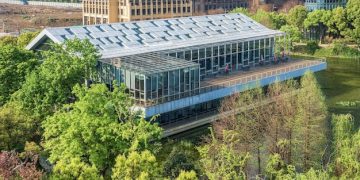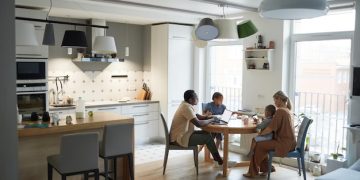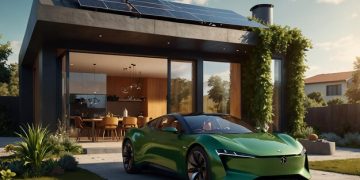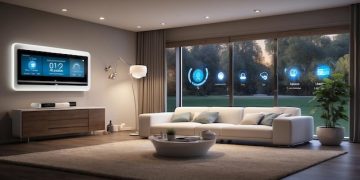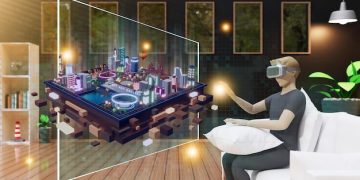The Future of Interior Design: Personalized Spaces & Biophilic Trends
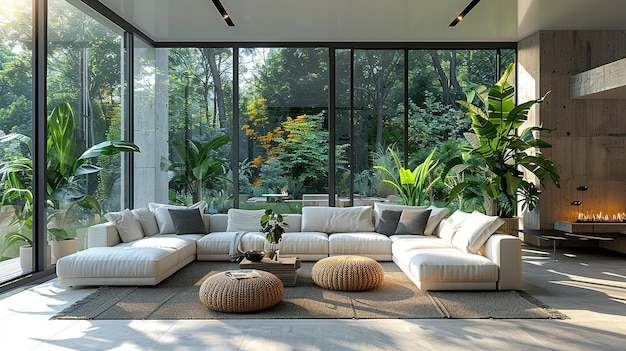
The future of interior design is leaning towards personalized spaces that reflect individual lifestyles while integrating biophilic design principles to enhance the connection with nature, promoting well-being and sustainability.
The modern home is evolving into a personal sanctuary, reflecting individual tastes and promoting well-being. The future of interior design emphasizes personalized spaces and the incorporation of biophilic design principles, blending technology with nature to create harmonious and sustainable living environments.
Personalization: Designing Spaces That Reflect You
Personalization in interior design is about creating spaces that truly reflect the individual or family living there. It goes beyond mere aesthetics, delving into how people live, work, and relax within their homes.
This approach focuses on tailoring the design to meet specific needs and preferences, ensuring that the home is not only beautiful but also functional and comfortable.
Understanding Individual Needs
The first step in personalization is understanding the needs and preferences of the occupants. This involves in-depth consultations and analyses of their daily routines, hobbies, and lifestyles.
Customized Layouts and Functions
Based on the needs assessment, designers can create customized layouts and functions within the home. This might include creating a dedicated home office, a relaxing reading nook, or a state-of-the-art entertainment center.
- Prioritize functionality to enhance daily living.
- Incorporate personal touches that reflect individuality.
- Use flexible design elements that can adapt to changing needs.
Ultimately, personalized interior design is about creating a space that feels like home, reflecting the unique identity and enhancing the well-being of its occupants. This approach ensures that the home is not just a beautifully decorated space, but a functional and comfortable environment that supports the lifestyle and aspirations of those who live there.
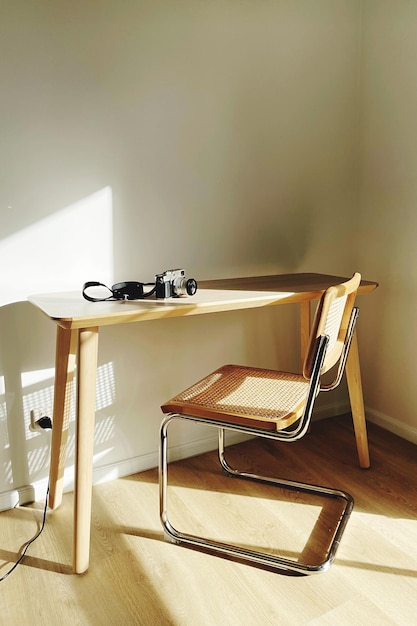
Biophilic Design: Bringing Nature Indoors
Biophilic design is an innovative approach that seeks to connect building occupants more closely to nature. Rooted in the concept that humans have an innate affinity for the natural world, it integrates natural elements and patterns into the built environment.
The goal is to enhance psychological well-being, reduce stress, and improve overall health by creating spaces that mimic or incorporate natural settings.
Elements of Biophilic Design
Biophilic design incorporates a variety of elements, including natural light, ventilation, plants, water features, and natural materials. These elements are carefully integrated to create a harmonious and restorative environment.
Natural light and ventilation are maximized to enhance the connection with the outdoors. Plants are strategically placed to improve air quality and create a sense of tranquility. Water features, such as fountains or aquariums, add a soothing element, while natural materials like wood, stone, and bamboo bring texture and warmth to the space.
- Maximize natural light and ventilation.
- Incorporate plants and water features.
- Use natural materials like wood and stone.
By incorporating these elements, biophilic design aims to create spaces that are not only aesthetically pleasing but also beneficial for the health and well-being of the occupants. This approach recognizes the importance of our connection with nature and seeks to bring the healing power of the natural world into our homes and workplaces.
Smart Home Integration: Enhancing Comfort and Efficiency
Smart home technology is revolutionizing interior design by enhancing comfort, efficiency, and personalization. By integrating smart devices and systems, homeowners can create living spaces that adapt to their needs and preferences, providing seamless control over various aspects of their home environment.
From automated lighting and temperature control to advanced security systems and entertainment options, smart home integration is transforming how we interact with our living spaces.
Automated Systems and Personalization
One of the key benefits of smart home integration is the ability to automate various systems, making daily life more convenient and efficient. Lighting, temperature, and security can be controlled remotely or programmed to adjust automatically based on the time of day or occupancy.
Personalization is another significant advantage. Smart home systems can learn the preferences of the occupants and adjust settings accordingly. For example, the lights can dim automatically in the evening, and the temperature can be adjusted to the ideal comfort level.
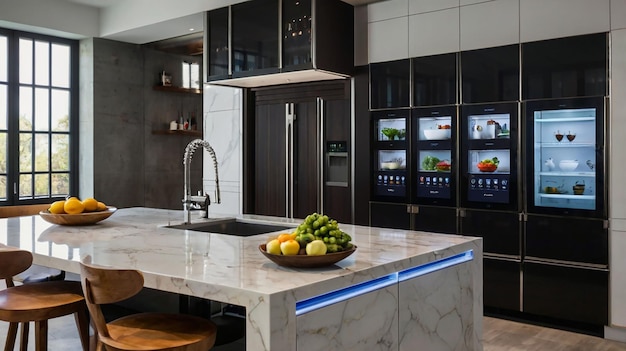
- Implement automated lighting and temperature control.
- Integrate advanced security systems.
- Customize settings based on personal preferences.
Smart home integration also promotes energy efficiency, helping homeowners reduce their carbon footprint and save money on utility bills. By monitoring energy consumption and optimizing usage, smart home systems can contribute to a more sustainable lifestyle. Overall, smart home integration is enhancing comfort, efficiency, and personalization in interior design.
Sustainable Materials and Practices: Designing for the Future
Sustainable materials and practices are becoming increasingly important in interior design as homeowners and designers recognize the need to reduce their environmental impact. This approach involves selecting materials that are renewable, recycled, or sustainably sourced, and implementing practices that minimize waste and energy consumption.
By prioritizing sustainability, designers can create spaces that are not only beautiful and functional but also environmentally responsible.
Eco-Friendly Material Choices
Choosing eco-friendly materials is a key aspect of sustainable design. This includes using materials like bamboo, cork, reclaimed wood, and recycled glass, which have a lower environmental footprint compared to traditional materials.
Bamboo is a fast-growing renewable resource, while cork is harvested from the bark of cork trees without harming the tree. Reclaimed wood gives new life to old materials, reducing the demand for virgin timber, and recycled glass transforms waste into beautiful and durable surfaces.
In summary, sustainable materials and practices are essential for creating living spaces that are both beautiful and environmentally responsible. By making conscious choices about materials and practices, homeowners and designers can contribute to a more sustainable future.
Adaptive and Flexible Spaces: Meeting Evolving Needs
Adaptive and flexible spaces are designed to meet the evolving needs of homeowners. These spaces are versatile and can be easily reconfigured to accommodate different activities and lifestyles. The concept revolves around creating environments that can adapt to changing circumstances.
Modular furniture, movable walls, and multi-functional designs are key elements in creating adaptive spaces. These elements allow homeowners to transform their living spaces according to their needs, whether it’s creating a home office, a guest room, or a larger entertainment area.
Multi-Functional Furniture and Movable Walls
Multi-functional furniture is designed to serve multiple purposes, maximizing the use of space. For example, a sofa bed can transform from a comfortable seating area to a guest bed, while a coffee table with storage can provide additional space for storing items.
Movable walls and partitions offer the flexibility to divide or open up spaces as needed. These elements allow homeowners to create private areas or expand their living spaces for larger gatherings.
- Incorporate multi-functional furniture.
- Utilize movable walls and partitions.
- Design spaces that can be easily reconfigured.
Ultimately, adaptive and flexible spaces are about creating living environments that can evolve and adapt to the changing needs and lifestyles of the occupants. This approach ensures that the home remains functional, comfortable, and relevant over time.
Color Psychology and Well-Being: Harnessing the Power of Color
Color psychology plays a crucial role in interior design, influencing mood, emotions, and overall well-being. The colors used in a living space can have a significant impact on the occupants, affecting their energy levels, relaxation, and productivity.
Understanding the psychological effects of different colors allows designers to create spaces that promote positive emotions and enhance well-being. Warm colors like red, orange, and yellow evoke feelings of energy and excitement, while cool colors like blue, green, and purple promote calmness and relaxation.
Choosing Colors for Emotional Impact
Selecting colors based on their emotional impact is essential for creating a harmonious and supportive living environment. For example, using calming blues and greens in a bedroom can promote restful sleep, while incorporating energizing yellows and oranges in a home office can enhance creativity and focus.
Neutral colors like white, gray, and beige provide a versatile backdrop that can be easily accented with pops of color. These colors create a sense of spaciousness and tranquility, allowing other design elements to stand out.
Key Point
Brief Description
🌱 Biophilic Design
Incorporating natural elements like plants and light to enhance well-being.
🎨 Personalized Spaces
Tailoring designs to reflect individual needs and lifestyles.
💡 Smart Home Tech
Using automation for comfort, efficiency, and personalization.
♻️ Sustainable Materials
Choosing renewable and recycled materials to minimize environmental impact.
FAQ
▼
Biophilic design incorporates natural elements to connect people with nature, enhancing well-being and reducing stress. This includes using plants, natural light, and sustainable materials in interior spaces.
▼
Personalizing a space involves tailoring the design to reflect your lifestyle and preferences. It includes incorporating personal items, custom layouts, and functional designs that meet your specific needs.
▼
Smart home integration enhances comfort and efficiency through automated lighting, temperature control, and advanced security systems. It allows personalized settings and promotes energy savings, contributing to a sustainable lifestyle.
▼
Sustainable materials reduce environmental impact by using renewable, recycled, or sustainably sourced resources. This minimizes waste, conserves energy, and supports a more environmentally responsible approach to design.
▼
Adaptive spaces are designed to be versatile and easily reconfigured to accommodate changing lifestyles. They incorporate multi-functional furniture and movable walls, allowing homeowners to transform spaces as needed.
Conclusion
The future of interior design is an exciting blend of personalization, nature, and technology. By embracing these trends, homeowners can create living spaces that are not only beautiful and functional but also supportive of their well-being and the environment.
